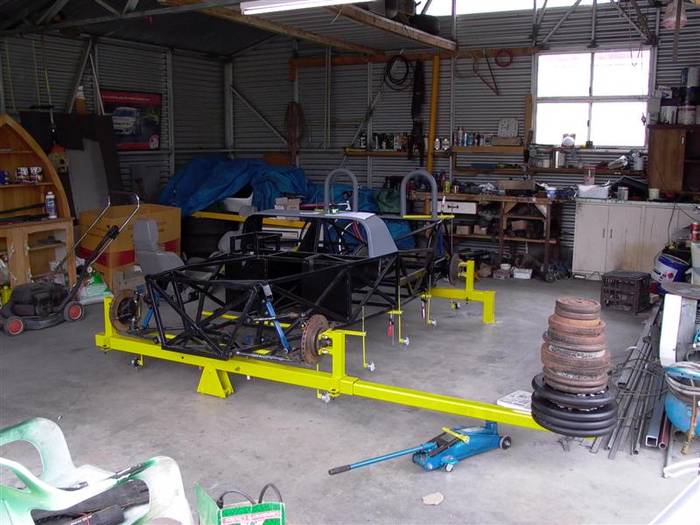Sub-frame connectors... Please build them correctly!
That is one way to test for torsional rigidity, yes. Proper? Again, this is totally misleading. The test shows a weighted lever arm applied to the front suspension, but the rear suspension is constrained and even the front suspension is locked out using fixed rods instead of the usual springs and shocks. Yes, it gives you a torsional rigidity number, and it is a fairly common way to test torsional rigidity because it's pretty simple (ie, easily repeatable). But how that number relates to how the chassis actually behaves going down the road is a different story.
In about two seconds I found this nice post on a Formula SAE board. If you don't know, formula SAE (society of automotive engineers) is a yearly competition for college engineering students where they design and race what amounts to a 2/3 scale formula-1 style car powered by a 600cc motorcycle powerplant. I was a member of a FSAE team the first couple years I was in college. Anyway, it's a nice, simple explanation of the shortcomings of the test you show.
https://www.reddit.com/r/FSAE/comments/39rpow/best_way_to_test_simulation_and_physical_chassis/
My point here isn't to be contrary. My point is that there are dozens of different methods to test something like how subframe connectors will effect the chassis, all with varying degrees of accuracy and relevance to the real world. And even among engineers, you will run into a spectrum of opinions on which tests are most valid. The test you show is just a single method, and in a lot of cases it's just used to compare the results of a computational model to a simple real world test to check the validity of the computer model that was used. If the model lines up with the results of the test then the computational model can be used to determine more relevant loading scenarios.
And even if you accepted that particular test as the standard benchmark way to conduct your tests (which is reasonable, and that test is used as a benchmark for certain applications), all you could really say at the end of it was that in that particular test one type of connector outperformed the other. It's not an end-all, be-all kind of deal, as the short discussion I linked helps to point out.
That is one way to test for torsional rigidity, yes. Proper? Again, this is totally misleading. The test shows a weighted lever arm applied to the front suspension, but the rear suspension is constrained and even the front suspension is locked out using fixed rods instead of the usual springs and shocks. Yes, it gives you a torsional rigidity number, and it is a fairly common way to test torsional rigidity because it's pretty simple (ie, easily repeatable). But how that number relates to how the chassis actually behaves going down the road is a different story.
In about two seconds I found this nice post on a Formula SAE board. If you don't know, formula SAE (society of automotive engineers) is a yearly competition for college engineering students where they design and race what amounts to a 2/3 scale formula-1 style car powered by a 600cc motorcycle powerplant. I was a member of a FSAE team the first couple years I was in college. Anyway, it's a nice, simple explanation of the shortcomings of the test you show.
https://www.reddit.com/r/FSAE/comments/39rpow/best_way_to_test_simulation_and_physical_chassis/
My point here isn't to be contrary. My point is that there are dozens of different methods to test something like how subframe connectors will effect the chassis, all with varying degrees of accuracy and relevance to the real world. And even among engineers, you will run into a spectrum of opinions on which tests are most valid. The test you show is just a single method, and in a lot of cases it's just used to compare the results of a computational model to a simple real world test to check the validity of the computer model that was used. If the model lines up with the results of the test then the computational model can be used to determine more relevant loading scenarios.
And even if you accepted that particular test as the standard benchmark way to conduct your tests (which is reasonable, and that test is used as a benchmark for certain applications), all you could really say at the end of it was that in that particular test one type of connector outperformed the other. It's not an end-all, be-all kind of deal, as the short discussion I linked helps to point out.
